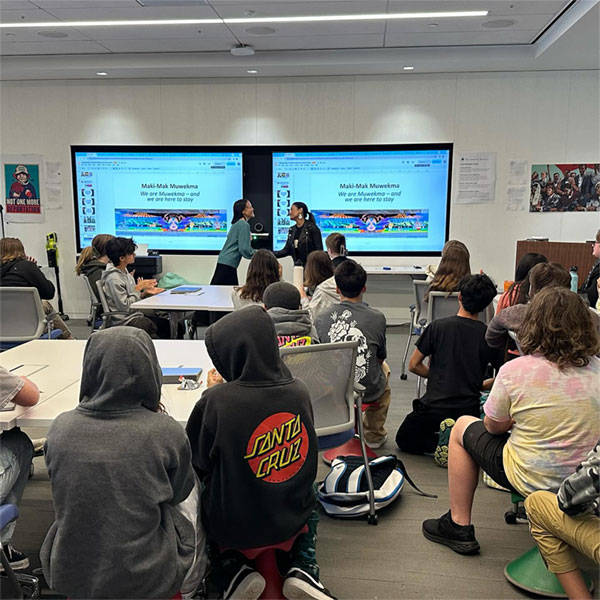Stanford's Relationships with Native Peoples
 Stanford ranks among the best and most prestigious of American universities. Admission is limited to the brightest students. The education that students receive here is the best in the world. While graduates from the University go on to become contributing members of modern society, it should not be forgotten that the roots of Stanford University lie in the land that belonged to Native Americans and if not for this land, the University would not exist today. The University acknowledges this and it is the reason why there is a special relationship with the Native people of North America.
Stanford ranks among the best and most prestigious of American universities. Admission is limited to the brightest students. The education that students receive here is the best in the world. While graduates from the University go on to become contributing members of modern society, it should not be forgotten that the roots of Stanford University lie in the land that belonged to Native Americans and if not for this land, the University would not exist today. The University acknowledges this and it is the reason why there is a special relationship with the Native people of North America.
Stanford ranks among the best and most prestigious of American universities. Admission is limited to the brightest students. The education that students receive here is the best in the world. While graduates from the University go on to become contributing members of modern society, it should not be forgotten that the roots of Stanford University lie in the land that belonged to Native Americans and if not for this land, the University would not exist today. The University acknowledges this and it is the reason why there is a special relationship with the Native people of North America.
The Land
In the 1870s and 1880s, Governor Leland Stanford bought land in California to create the University that bears his name. The fact that this land belonged to the Muwekma Ohlone tribe was of no consequence to him. In the 1860s, he raised an armed volunteer force that was tasked with preventing the “repeated incursions of hostile Indians.” Once the land was cleared of the people who had lived there for millennia and who were among the original inhabitants of the continent, a huge sum (at that time) of $20 million was spent on setting up the University. In a telling indictment of the bigotry that the Ohlone faced, the architecture of the campus was designed to replicate the style of the Spanish missions of California which subjected the members of the tribe to a ruthless system of forced labor, equivalent to slavery into Missions San Francisco, Santa Clara, Santa Cruz, and San Jose.
With an increased awareness of the evils of the past that spread across the country in the 20th century, a reevaluation of the history of the university began. Throughout the century, archaeological research was undertaken to learn more about the story of Stanford University’s origins. However, it was not until the 1980s that the University approached the Muwekma to become part of the process. Over time, mutual trust and understanding have become the foundation of the relationship between the University and the Tribe and the University has increased its focus on the Native people on whose land it exists today.
Also Read: The Native American Superpower | Challenges in Reestablishing Muwekma Ohlone Tribal Identity
The People
The beginning in the 1960s presence of Indians on campus may have been limited but the University now has a vibrant Native American community that encompasses staff, faculty, students and alumni. The over 400 students now enrolled represent more than 50 Tribes, including the Ohlone, the original occupants of the land. Today, the Native American theme house Muwekma-Tah-Ruk (House of the People), Native American studies, Native American cultural center programming, Stanford American Indian organization events, historic interpretation, community-led archaeology, and a native plant garden are all part of the Stanford ethos. In 1988 Stanford’s Native American faculty, staff, students and alumni community decided to honor the Muwekma by changing the name of the Native American theme House from Lathrop to Muwekma-Tah-Ruk.
Land Acknowledgement
The University, working with the Muwekma leadership, has acknowledged the debt it owes to Native people. The Stanford Land Acknowledgement Statement says “Stanford sits on the ancestral land of the Muwekma Ohlone Tribe. This land was and continues to be of great importance to the Ohlone people. Consistent with our values of community and inclusion, we have a responsibility to acknowledge, honor, and make visible the University’s relationship to Native peoples.”
Today, Stanford’s relationship with Native peoples sets an example for others to emulate. While there is still much to be done, the Muwekma Ohlone and Stanford University are working together to increase awareness of the injustices of the past and by doing so, are creating a system that will prevent it from occurring again in the future. Stanford's relationship with Native peoples is an example that others will, hopefully, follow.
Other than the Muwekma Ohlone presenting information on the history and heritage of the Tribe at Stanford, the University hired former Tribal Councilwoman Susanne Rodriguez as an on-campus tribal liaison to work with Stanford administrators on the Tribe’s ancestral; heritage projects. Furthermore, Stanford hired the Muwekma Tribe’s Cultural Resource Management Arm, to conduct several recovery projects that would have impacted the Tribe’s ancestral heritage cemetery sites.
Report on the Recovery, Analysis and AMS Dating of Ancestral Muwekma Ohlone Human Remains Recovered from the Horše ’Iššéete Ruwwatka [Place of the Good Health House Site] (Ronald McDonald House/CA-SCL-609) Located at 520 Sand Hill Road, Palo Alto, Santa Clara County, California.
Final Report on the Burial and Archaeological Data Recovery Program Conducted on a Portion of a Middle Period Ohlone Indian Cemetery, Yuki Kutsuimi Šaatoš Inūxw [Sand Hill Road] Sites: CA-SCL-287 and CA-SMA-263, Stanford University, California
- Mar 14, 2024
